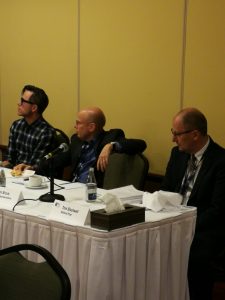
L-R panelists Timothy Caulfield, William Brock and Tom Blackwell, TMM 2017
Timothy Caulfield is a crusader against pseudoscience and “scienceploitation” as he likes to call the field of exploiting science for marketing purposes. He was one of the speakers in a lunch time panel, at the recent Till & McCulloch Meetings, on ethical, legal and social issues. The title of the panel was “Science for Citizens: Navigating the Challenges and Opportunities for Public Engagement in Stem Cell Policymaking”.
His amusing presentation, full of references to stem cell “bras” and stem cell “facials” – I’ve covered this before, read about it here – and a stem cell product that can apparently improve a woman’s sex life, was nevertheless serious and sobering too.
Between fake news (read the study), implicit hype (perpetrated by unwitting media reporting on such things as stem cell injections for athletes), crowd sourcing (helping someone raise money to have a stem cell treatment abroad and thereby endorsing the procedure) and “quackajournals” (as Timothy Caulfield calls them), we are fostering a climate where it can be hard to discern legitimate science and products amidst the bunk. Obviously, this is harmful to the reputation of the stem cell industry and puts into question whether the science even works. More crucially, the public can be seriously harmed, which could lead to a halt in stem cell research funding, setting the industry back by decades.
So, what’s a scientist to do? Here are some thoughts:
- Don’t hype your research, even to get funding.
- Don’t allow your university or company to issue a news release that hypes your discovery.
- Don’t publish in predatory journals just to increase your publications. According to The New York Times, there are now more than 10,000 of them!
- Help disseminate the International Society for Stem Cell Research’s Patient Handbook on Stem Cell Therapies.
- Educate anyone who will listen. Doing public outreach is crucial, especially with fewer and fewer science reporters around to fill this role, and also contextualize and scrutinize research and findings.
- Report infractions you witness, such as from unregulated stem cell clinics, to Health Canada and the Competition Bureau.
I’ve shared some slides from Timothy Caulfield’s presentation.
Do you have other suggestions to help stem the tide? Please comment below.




Our regular feature, Right Turn, appears every Friday and we invite you to submit your own blog to info(at)ccrm.ca. We encourage you to be creative and use the right (!) side of your brain. We dare you to make us laugh! Right Turn features cartoons, photos, videos and other content to amuse, educate and encourage discussion.
As always, we welcome your feedback in the comment section.
Stacey Johnson
Latest posts by Stacey Johnson (see all)
- Right Turn: Beyond the ’stache: The science, the progress, the promise - November 26, 2025
- Right Turn: Can Bryan Johnson live forever? Will regenerative medicine help him do so? - October 10, 2025
- Right Turn: #pinksocks, diabetes news and other ramblings - June 24, 2025






Comments